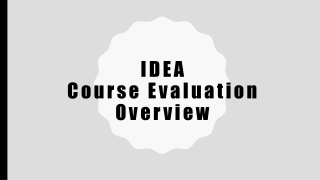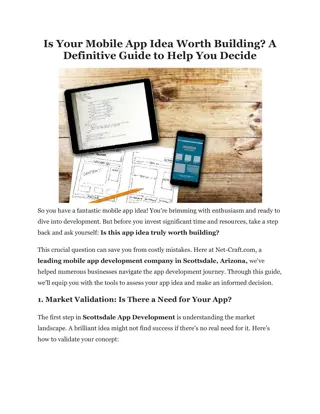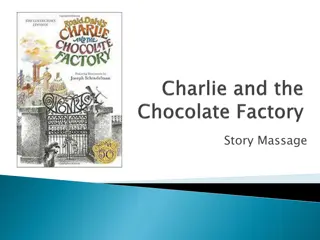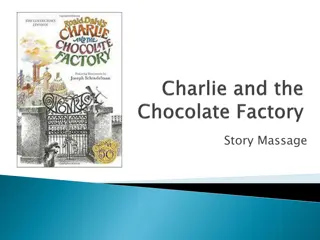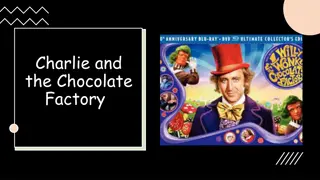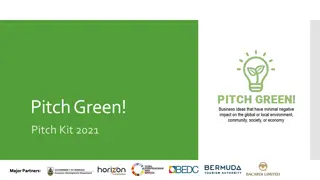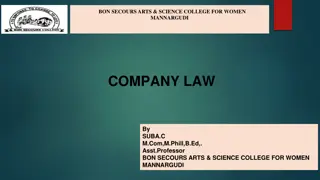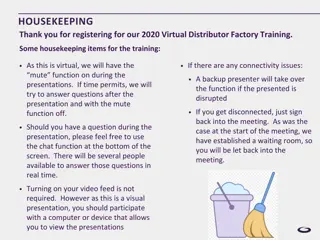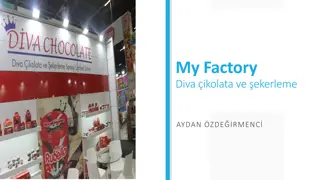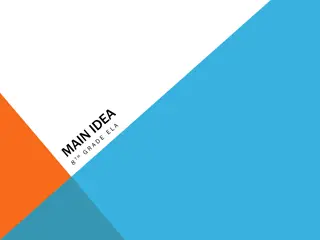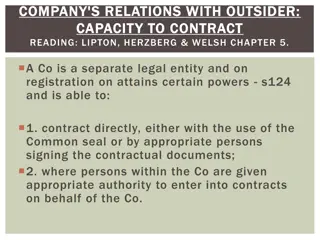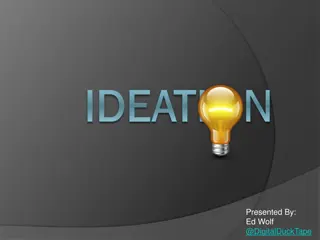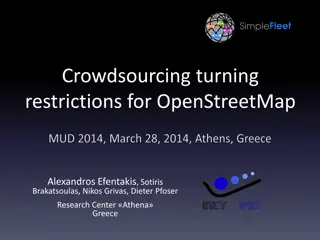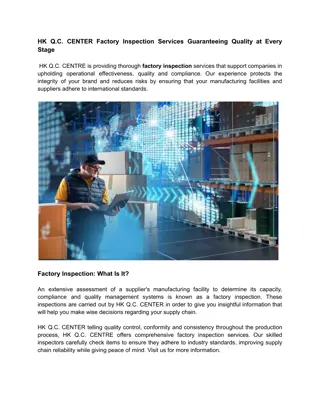
Unlocking Creativity in Your Company: Building an Idea Factory
Transform your company into an idea factory by selecting the right creative team, engaging in structured creative sessions, involving customers and experts, and embracing diverse creativity styles for innovative new product development.
Download Presentation

Please find below an Image/Link to download the presentation.
The content on the website is provided AS IS for your information and personal use only. It may not be sold, licensed, or shared on other websites without obtaining consent from the author. If you encounter any issues during the download, it is possible that the publisher has removed the file from their server.
You are allowed to download the files provided on this website for personal or commercial use, subject to the condition that they are used lawfully. All files are the property of their respective owners.
The content on the website is provided AS IS for your information and personal use only. It may not be sold, licensed, or shared on other websites without obtaining consent from the author.
E N D
Presentation Transcript
1. Identifying the right people to work in the idea factory 2. Preparing the creative session 3. Taking your creative team outside the box 4. Bringing your customers into the process 5. Involving experts to provide additional information 6. Stimulating the team s creative right brain
We want your company to be an idea factory a place where ideas for new products pop up all over the place. Ideas are the starting point for new product development success. Without creativity without the ability to see what could be rather than only what is a company can t come up with new products of any kind. Coming up with ideas for new products isn t a random occurrence. It doesn t happen just because you, by chance, hired very creative people. Becoming an idea factory requires the creation of an environment and a process that enable your company to continually generate new ideas in abundance.
Some companies rely on individual contributors to come up with great ideas, and others have processes in place for soliciting new ideas from employees. Both of these strategies can be effective, but in this section we focus on the most powerful and predictable way of generating new ideas: selecting and using a creative team.
The teams that develop new products cross-functional teams should be included on your creative teams, but you shouldn t limit yourself to the functional experts who know how to do what it takes to develop new products. Reach out beyond the experts to bring in the kooky, the uninhibited, the scientific, and the curious in other words, the folks in your company and outside your company who will bring spice and fire to your proceedings.
Some companies rely on individual contributors to come up with great ideas, and others have processes in place for soliciting new ideas from employees. Both of these strategies can be effective, but in this section we focus on the most powerful and predictable way of generating new ideas: selecting and using a creative team.
Creativity style differences are real. You may even say theyre hardwired in everyone. People process information differently and relate to people and tasks differently. For example, some people respond to problems by coming up with ideas that improve the existing system; others tend to generate more radical ideas ones that call for drastic changes. As you put together your creative team, you need to be aware of these differences. When you have different creativity styles working together, you get the best of all worlds.
When forming a team that will stock your companys inventory of new product ideas, you must remember that diversity is essential. You need people with different types of creativity styles (see the previous section). Furthermore, you should add people with different skills, experiences, and roles in the company, because they ll see processes and ideas from different points of view and will approach the task of being creative differently. Marketers will come up with different ideas than engineers or software experts; together, they ll come up with ideas that none of them would ve thought of alone. You should also include people of differing age, gender, and cultural or ethnic background whenever possible.
If youve carried out a customer visit program and, ideally, you should do this before the creativity sessions you should have plenty of information from customers on what they dislike in the marketplace and on what they desire and need from prospective products (flip to Chapter 4 if you want to get going on customer visits). In addition to sharing information from customer visits with the creative team, it can be very useful to include customers as members of the creative team.
Finding customers. One of the easiest ways to involve customers on a creative team is to invite employees from your own company who are members of the target customer group. Scheduling a session with customers in mind. You should always allocate at least two days for a creative session (see the following section for more on setting up sessions) especially when you re working with customers. You can invite the customers to participate on the first day and then spend the second day fleshing out the customer input in an employees-only session.
Creativity may seem like a random or lucky experience; it can be, but more often it s the result of careful planning. An idea generation session needs structure. The people who attend the session the creative team need to place all their attention and energies on coming up with ideas. The environment of the meeting should make this easy for them. Why aren t people creative all the time? Probably because their attention is pulled to other, more practical matters. People have things to do, others to meet, reports to write, research to do, and so on. While the team members are working together, they should have as few of these distractions as possible, because your creative team should experience the luxury of being able to focus all their attention on coming up with good ideas.
The session managers first duty is to communicate with the meeting attendees to give them the details of the session. Be very clear about the timing the date of the meeting and the meeting times and the logistics. Most creative sessions are two-day affairs, so be sure to let them know whether a dinner will be served for the group.
You have all kinds of details to consider when youre setting up a creative session. You ll want to provide the following for session participants: Comfortable seating in a comfortable room; Snacks, drinks, and meals as appropriate; Pre-work displayed for all to see. You also need the right materials to support the creative session. At a mini- mum, you need an ample supply of the following: Flip chart paper Markers Sticky notes Felt-tip pens Tape
The creative session participants will be spending quite a bit of time together. The more comfortable they are with each other, the more they ll open up and share their thoughts. Start the creative session with informal introductions. Even if the participants already know each other, they may know each other only as colleagues, bosses, and so on in the everyday world of work. An ice- breaker establishes the possibility of another kind of relationship one in which the participants are free to say what they think, make mistakes, be outrageous, and have fun.
Here are a few icebreakers that work well: Ask participants to draw pictures of themselves to show to the group. When they introduce themselves, ask them to describe how the pictures reveal something about them. Ask them to share personal facts that no one in the room is aware of. Ask them to share what excites them about the project and what they hope won t happen. Ask them to tell the group about where they were born, using little- known facts. One of co-author Beebe Nelson s colleagues, who lives in Quincy, Massachusetts, introduced himself as coming from the city of dead presidents.
After the participants of the creative session get acquainted, the facilitator or session leader needs to present a clear statement of the problem that the ses- sion is intended to solve. This statement must be much more specific than a broad question like, What new products can we come up with for our company?
The group members should have a general idea of why they ve been invited to participate in the session, but they ll be able to focus their work much better if they have a statement or question that has the following characteristics: Is clear and concise Addresses the true issue/problem Includes any necessary boundary conditions
You hear the phrase Think outside the box all the time, but what does it really mean, and where did it originate? It comes from a puzzle that asks you to connect nine dots in straight lines without raising your pencil. To complete the task, you have to go, literally, outside the box. Thinking outside the box is divergent thinking. Creative thinking doesn t judge the results. It seeks novelty in whatever occurs during the thinking process. It builds on whatever anyone has said. It asks How? in a spirit of curiosity. It doesn t say Yes, but, it says Yes, and . . . shorthand for open-ended,
We like to start creative sessions by emptying the box. What does this mean? Well, when you re presented with a problem to solve, you immediately put it in the context of what you already know. Therefore, the first ideas that come to mind usually are familiar, already understood, and easy to think about. These ideas represent the easy solutions. They may work, but they aren t outside the box. You want to get these ideas out on the table; until you do, the creative team will have trouble moving on to the out-of-the-box ideas.
Each person writes down a minimum of 10 to 15 ideas on individual sticky notes. Each person passes her note(s) to the person on her right. Each person reviews the note(s) she receives and writes down three new ideas. Each person passes the notes to the right again, and the group pairs off. The pairs review and discuss the notes in front of them and come up with a minimum of three to five more ideas. The pairs paste their ideas on a flip chart page (or two) for everyone to look at and discuss.
After the group has empty brains, the members will find it easier to come up with more creative ideas by brainstorming. The term brainstorming refers to the many methods of generating a large number of creative ideas with a group. You can use brainstorming all by yourself when you re trying to find creative ways to solve a problem. And you can use it over and over during the session to capture the ideas that the group comes up with.
The following list presents the basic steps of brainstorming: 1. Post the brainstorming ground rules. 2. Set the brainstorming agenda. 3. Display the problem statement for the whole creative session, or draft one that focuses on a specific issue you want the team to address. 4. Begin the brainstorming by asking people to call out ideas or to write them on sticky notes. 5. Write up or post all the grouped ideas, and then have the team mem- bers vote by placing check marks or dots on the ideas or themes they like. 6. Put the most popular ideas on a clean wall or flip chart page. 7. Pair up the group members and have each pair use the popular ideas to create a new, composite idea. 8. Post these ideas and have the whole group review, critique, and build on them.
Mindmapping is becoming increasingly popular for stimulating both individual and group creativity. Mindmapping is a great way to come up with plenty of ideas quickly and to help the creative group find themes or issues it may have overlooked.
To mindmap, you follow these steps: 1. Pose a question and write it at the center of a large piece of paper, which you hang on the wall. 2. The session manager or facilitator asks for major themes that relate to the question. 3. The session manager draws lines that jet out from the central question like the arms of a spider web and labels each arm with one of the themes. 4. The group starts to brainstorm solutions that may serve the different themes.
One of the best ways to inspire creativity in your team and certainly a method that s out of the box is to go on a creative excursion. Many teams use excursions to set up a brainstorming session. You define the problem say, for example, How can we meet our customers needs for increased safety in using our product? After you empty the box and brainstorm ideas, your team is struggling to come up with ideas. Give them a break! After some coffee and doughnuts (or fruit and cookies), you can start the excursions.
Even if actual customers dont participate in your idea- generation sessions, the session manager(s) or facilitator should make sure to have as much knowledge of the customer as possible in the room to inspire and focus the group. A small group the session manager(s) and the facilitator, for example should take time before a session to gather known customer information and put it in a form that will provoke creativity. (See Chapter 4 for tips on customer visits.)
During the idea session, if you have photos of customers or of customer environments, post them. Perhaps you have a map that shows where your target customers are; at times during the idea session, the facilitator may ask the group to focus just on the customers in Canada, or just on customers in Japan, or just on teenaged boys, and so on.
If youve done a customer visit program (see Chapter 4), you already have a list of customer requirements that you can use to come up with ideas and solutions. But even if you haven t followed the customer visit process, you can brainstorm a list of requirements, or customer needs, that your creative team s solutions will address (see the earlier section Brainstorming ). Your objective in creating new products, after all, is to give your customers what they need and want. Here s how the process should go:
Post and review your customer information. Ask the team to brainstorm requirements. Here are a few I can statements that capture the requirements of patients who use medical devices: I can hold onto my device with my arthritic hands. I can carry my device with me inconspicuously. I can clean my device easily. If you ve made a customer requirements tree by following the instructions in Chapter 4, you can use that. Narrow down the requirements by voting, and then group them into not more than four or five groups of similar requirements. Post each group of requirements on the wall of the meeting room, and instruct the team members to wander around the room thinking of solutions for each specific requirement.
When your creative team has produced many ideas and solutions for the individual customer requirements you ve identified or brainstormed, take a break! When you regroup, the next step is to gather the solution ideas into concepts (you can use the Idea Form we include in Chapter 6). Each member of the team should wander around the room to collect ideas from the earlier brainstorming to blend into a concept. Let the participants know that they can deviate from, build on, or change the ideas they find on the requirements sheets. They can even come up with totally new solutions that no one thought of before the break!
In this chapter, weve described plenty of activities you can conduct to come up with ideas and concepts for new products. But we couldn t resist adding a few more! After all, this chapter is about being creative, and there s no limit to the things a creative mind can do. In this section, we explain how you can bring in experts from outside the company to expand the team s appreciation of market and technology issues. We also describe some ways that creative teams can use their artistic propensities in the service of coming up with the next, best ideas.
Information about technology and market trends information that can come from experts inside or outside your company can really help your team think outside the company box. What new technologies are being developed in industries that impact yours? What are the latest market trends that could affect your customers? For example, has someone developed a new way of delivering oxygen that may impact the medical devices you can develop? Are farmers beginning to use a different line of plowing equipment? How are young professionals dressing these days?
For your informational sessions, which should run at least one day (and preferably two), you need clear focus statements to start the days (and to prepare your speakers; see the following section). The problem statement specifies both the customers whom you want to create product ideas for and what issues most interest you.
After youve framed your questions, do some research with people in your company and on the Internet to identify who the experts are. You want them to visit you to answer your questions that is, to deliver the wealth of wisdom they have on the topic you re interested in. Often, cold-calls to these experts can secure a visit commitment. If not, use the cold- calls to ask the known experts who they can recommend for an invitation.
The output of the expert session should be a number insights that relate to the problem area you want to solve for customers. Use the brainstorming process to collect the team s insights and narrow them down. If the team creates story- boards to depict what they ve learned, these storyboards can be brought into the room and used as a focus for brainstorming during the creative session. (See the next section for tips on how to create and use storyboards.)
Creative idea generation sessions draw more on a participants right brain than the left. Your right brain is the more intuitive part that sees things in pictures and that makes nonlinear connections. It leaps to conclusions from scant bits of data; that can be bad in some situations, but when you re being creative, it s all good. Plan your idea generation session to include some right-brain activities, and have a few in reserve in case you find the energy lagging. A good facilitator can sense when the creative team needs more fuel and will depart from the set agenda to include playtime. The tools we describe in this section give your team members a chance to do the right-brained activities usually reserved for artists and kids: drawing, model building,
Storyboards and skits are particularly useful tools to insert the customer experience right into the creative session and right into the team members emotional centers. These tools require that your team get creative artistically creative. We re always surprised and pleased to see how quickly people who ve never drawn, painted, or acted get into these activities.
Storyboards tell a story . Here s how to construct a storyboard: 1. Hold an information-gathering session, such as an expert session (see the section Bring in the experts! ) or a program of customer visits (see Chapter 4). 2. Identify key themes or insights from the session. 3. Pair off your team members, and have each pair choose a theme or insight that they want to work on. 4. Have each pair create a poster-sized storyboard that captures the insight in pictures and words. The more the pairs think like Disney cartoonists, the more interesting and useful their storyboards will be.
Storyboards tell a story . Here s how to construct a storyboard: 5. Halfway through the storyboarding session, bring the groups together to share what they ve done so far. Encourage feedback from all the pairs. The team members should let each other know what they see, feel, and understand when they look at the storyboards; they also should ask questions about anything that s unclear and offer suggestions for how to make the storyboards more interesting. 6. Have the pairs go back to complete their storyboards. Make sure each pair is clear that their storyboard has to stand on its own. If something on the storyboard requires explanation, the team members have to figure out a way to make it self-explanatory to people at the creative session.
Skits bring customers right into the room . You can turn your creative team members into thespians in order to carry out skits. Seriously, can you picture a group of marketers, engineers, manufacturers, executives, financial experts, and purchasing agents willingly playing roles and acting out scenes in their customers lives? We couldn t either, but after we tried it a couple of times, we realized that we re all hams under the surface, and we all love stepping into other worlds and acting out.
Building a rough concept model. Building a rough model of an idea or concept helps to flesh out the idea and can help the team see new ways to improve it. We re not talking about proto- typing here; we re talking about using bits and pieces of stuff to create a first rough model of the idea or concept (for information on prototyping, see Chapters 9, 14, and 17). Drawings of ideas are great, too, but the three-dimensionality and the humor in people s models provide both serious and light input to the process. .


